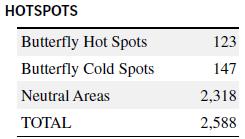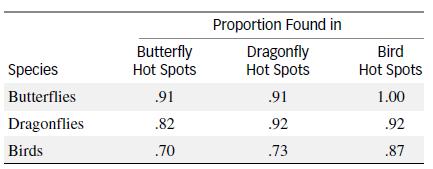Refer to the Nature (Sept. 1993) study of animal and plant species hot spots in Great Britain,
Question:
Refer to the Nature (Sept. 1993) study of animal and plant species “hot spots” in Great Britain, Exercise 3.81. A hot spot is defined as a 10-km square area that is species-rich, i.e., that is heavily populated by the species of interest. Similarly, a cold spot is a 10-km square area that is species-poor. The following table gives the number of butterfly hot spots and number of butterfly cold spots in a sample of 2,588 10-km square areas. In theory, 5% of the areas should be butterfly hot spots, 5% should be butterfly cold spots, with the remaining areas (90%) neutral. Test the theory using α = .01.

Data from exercise 3.81
Biologists define a “hot spot” as a species-rich geographical area (10-kilometer square). Nature (Sept. 1993) reported on a study of hot spots for several rare British species, including butterflies, dragonflies, and breeding birds. The table on pg. 130 gives the proportion of a particular species found in a hot spot for that or another species. For example, the value in the lower left corner, .70, implies that 70% of all British bird species inhabit a butterfly hot spot.

Step by Step Answer:

Statistics For Engineering And The Sciences
ISBN: 9781498728850
6th Edition
Authors: William M. Mendenhall, Terry L. Sincich





